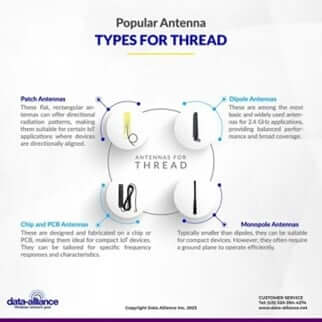Antennas, Antenna Cables, Wireless Products: Technical Articles
Thread IoT Wireless Protocol: Best Antenna Options
Antennas for Thread IoT Wireless Protocol

In the realm of wireless communication, an antenna is a central component, responsible for sending and receiving electromagnetic waves. With the advent of the Internet of Things (IoT) and the subsequent rise of various wireless communication standards, the role of antennas has become more crucial. Thread, a relatively new IoT protocol that's been gaining traction for its robustness and efficiency, is no exception. The choice and design of antennas for Thread play a significant role in the efficiency and reliability of the communication. This article delves into the importance, considerations, and nuances of antennas in the context of Thread IoT technology.
Why Antenna Choice is Critical for Thread
- Frequency Band: Thread operates in the 2.4 GHz ISM band. This band, shared by many other wireless technologies like Wi-Fi, Bluetooth, and ZigBee, is crowded. The right antenna ensures minimal interference and optimal performance within this spectrum.
- Low Power Requirement: Thread devices, often battery-powered, need to operate under stringent power constraints. An efficient antenna can enhance the signal's reach and clarity, reducing the need for re-transmissions and conserving energy.
- Mesh Networking: One of Thread's defining features is its mesh network capability. In such a setup, devices communicate not just with a central hub but with neighboring devices as well. An antenna optimized for such multi-node communication becomes essential to maintain a strong, interwoven network.
Considerations When Choosing an Antenna for Thread:
- Gain and Directivity: The gain of an antenna represents its efficiency in converting input power into radio waves in a specific direction. For a mesh network like Thread, an antenna with a balanced gain might be more beneficial than a high-gain one, which could result in blind spots.
- Polarization: Depending on the orientation and placement of devices, selecting the right polarization (linear, circular) can significantly affect the quality of communication.
- Bandwidth: Given that Thread operates in the 2.4 GHz band, the antenna should efficiently cover this frequency range without significant losses.
- Physical Dimensions: Especially in IoT applications where space can be at a premium, the size of the antenna is crucial. Modern designs like chip or PCB antennas can be integrated into small devices without compromising performance.
- Environment: The material composition of walls, presence of other electronic devices, and general environmental factors can impact wireless communication. Sometimes, specific antenna types or designs might be better suited to particular environments.
Popular Antenna Types for Thread:
- Dipole Antennas: These are among the most basic and widely used antennas for 2.4 GHz applications, providing balanced performance and broad coverage.
- Monopole Antennas: Typically smaller than dipoles, they can be suitable for compact devices. However, they often require a ground plane to operate efficiently.
- Chip and PCB Antennas: These are designed and fabricated on a chip or PCB, making them ideal for compact IoT devices. They can be tailored for specific frequency responses and characteristics.
- Patch Antennas: These flat, rectangular antennas can offer directional radiation patterns, making them suitable for certain IoT applications where devices are directionally aligned.
Compatibility is Key:
While the technical specifications we've discussed are important, choosing the right antenna also involves ensuring compatibility with the connector type on your Thread device. Different antennas come with different connector types, such as SMA, RP-SMA or U.FL. By checking your device's manual or specifications, you can ensure a seamless connection between the antenna and your Thread device.
In conclusion, while the Thread protocol provides a solid foundation for IoT communications, the choice and design of the antenna are pivotal to realize its full potential. A well-chosen antenna can maximize the efficiency, reliability, and range of Thread-based devices, ensuring seamless connectivity in our increasingly interconnected world.







